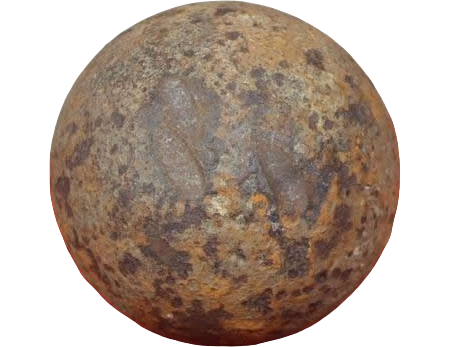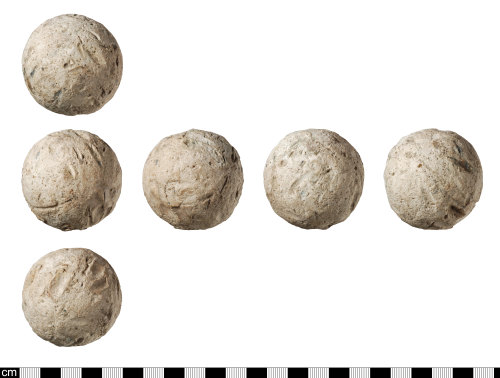An exhibition co-organised by the Society on the Forgotten Battle of St Albans was inspired in part by the rediscovery of a cannon ball from the battlefield, and a similar artefact found by a pupil 70 years after the event.

The recently rediscovered cannon ball from the Forgotten Battle of St Albans. © The Lanes Armoury
The cannon ball was prepared for use by the Lancastrian forces dug in on Bernards Heath, St Albans in May 1461. Their intelligence suggested that a Yorkist army would seek to pass through the town en route to London where they hoped to take the city and reinstall King Henry VI.
The cannon ball was cast individually from lead alloy – no mass production then. Like others, it was ‘roughly cast … the surface exhibits numerous marks, including linear grooves and shorter, shallow depressions, most of which are likely to be post-depositional damage’. [1]
As cannon balls went, it was not very large (47.1mm in diameter, weighing 460g (or as close to a pound as makes no difference) but nonethless effective against men and horses. [2]

The cannon ball from various angles © St Albans District Council
The Lancastrians stood ready to intercept their opponents. But the Yorkists outflanked them. The condition of the ball showed that it was never used in anger. Perhaps the damp conditions on that Wednesday (22 May 1461) meant that the gunpowder charge wouldn’t fire. Perhaps the firing position was overrun, or even by-passed. In any case, it was abandoned by the Lancastrians, and disappeared from sight.
Many winters later, on Saturday 14th February 2015, it was found by a detectorist, one of those responsible for so many exciting discoveries in recent decades. We don’t know who the detectorist was, but he (or she) did the right thing, and reported the find to the Portable Antiquities Scheme (PAS).
On the basis of expert advice from Professor Glenn Foard of the University of Huddersfield [3], the PAS determined that the cannon ball had been found close to the suggested site of the Second Battle of St Albans, making it a find of note, and of local importance. The cannon ball was returned to the finder, and exhibited in the St Albans Museum in 2016, after which it disappeared from view.
The cannon ball next surfaced in the Lanes Armoury in Brighton, where it was tracked down by SAHAAS President, Dr. John Morewood (also a member of the Battlefield Trust). Working with the Trust, he secured the ball for St Albans Museum.
St Albans Museums manager Farhana Begum said: “As a museum we know the power a single object has in bringing a story to life and so we’re very grateful to members of the two organisations for their efforts to bring this cannonball back to St Albans. We look forward to working with SAHAAS on a future exhibition which will showcase this and many other wonderful objects.” [4]
Now that exhibition has come to pass, and it runs from 24 March to 28 June 2023 in the St Albans Museum + Gallery.
And what of the other ball? Some 70 years after the battle, while playing truant from St Albans School in 1530, young Roger Shrimpton found a cannon ball in a ditch in north St Albans. Long after this could have got him into trouble, Roger (who subsequently had become mayor of the borough) reported his find in his memoirs. [5] It seems entirely plausible that this find also came from the same battle. Sadly for us, there was no PAS then (though even if there had been, is is unlikely Roger would have got himself into trouble by reporting the artefact).
[1] From the report of the Portable Antiquities Scheme (PAS). To find out more about how the scheme operates in Hertfordshire, read the account of the local Finds Liaison Officer.
[2] PAS
[3] Unique War of the Roses cannon ball rediscovered, Detecting Finds, Roger D. Spencer.
[4] Spencer, ibid.
[5] Conversation with Dr Peter Burley, Vice President of SAHAAS, on 8 February 2023.




